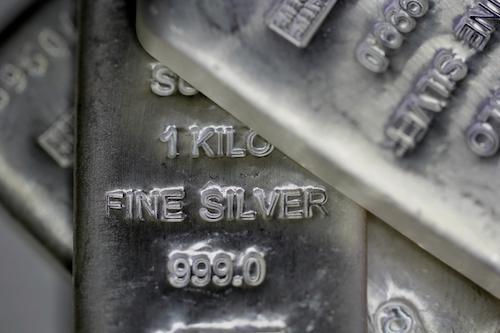
An Analysis of Silver: Support from the Gold and Silver Ratio
Silver bullion is probably the most contentious of precious metal investment choices at the moment. As the least costly per ounce of all the precious metals by far, it has appeal to the small investor and the major buyer because of its far greater leverage potential. For example, a price advance of only a few cents can mean a substantial percentage gain in value. However, a fall in price can still present an attractive buying opportunity because it's a lower bar to entry.
Over the years, the silver price has tended to move up and down with the gold price, but in a far more exaggerated manner. Thus positive movement in the gold price has tended to be accompanied by an even more valuable gain in the price of silver, but on the downside, the opposite is true. Over the years, the silver investor has tended to be guided by the Gold: Silver Ratio (GSR), which relates the silver price to a similar gold price weight. A high GSR tends to mean gold is doing better than silver, while a low GSR means the reverse. Over time, the GSR ratio has tended to remain between a low of 16 (hugely positive for silver) to a high of around 100, although this blew out to over 120. This high GSR ratio was seen as a silver buying opportunity by some in late March 2020.
It currently sits in the mid-70s, which is probably disappointing for the silver investor, and many times more so for the fanatical silver bull looking for a return to the 16 level which is seen as the historic norm.
Over the past 50 years, although the GSR has fluctuated between around 16 on the low side (back in early 1980 when the Hunt Brothers almost managed to 'corner' the global silver market and was thus something of a real anomaly) and up to over 120 in March 2020 (probably an equally anomalous level) the GSR has averaged perhaps in the high 50s. Whether this is still a realistic target level is the subject of much argument. (At $1,800 gold a GSR at say 56 would put the silver price at $32).
The GSR had fallen below 65 as recently as February this year but had come back up to around 77 in early August, demonstrating the metal's price volatility, and recent performance, vis-a-vis gold.
There has been a social media-inspired attempt at a silver short squeeze aimed at the bullion banks that hold vast silver short positions on COMEX in the U.S. But this seems to have been doomed to failure. Most banks that account for the big silver short positions also tend to have balancing holdings of physical metal and can offset the one against the other, which act as hedging positions for price movements up or down.
There are also conflicting arguments as to whether silver is in short supply, or in surplus in the face of what is seen as rising industrial demand – in the photo-voltaic and electronic sectors in particular. Some pro-silver arguers point to falling silver grades globally as an indicator of potential shortages ahead. In contrast, others say that higher prevailing silver prices (even though the silver price level at around $24 as at present is seen as disappointing by many silver investors, it should be remembered that silver was only at a little over $12 as recently as early 2020) have been enabling silver miners to work lower grade ores profitably thus enabling them to prolong mine lives rather than enhance short term payback. The global mining industry can be all about the sustainability of operations and employment rather than short-term profit maximization, whatever shareholders may seek.
Looking ahead, we see silver continuing to fluctuate in price. There are relatively few primary silver mines – most is produced as byproduct output from base metal and gold mining operations so the opportunity for rapid output increases is somewhat diminished. Still, as long as gold continues to show some strength – which we anticipate will continue for the foreseeable future due to the continuation, also for the foreseeable future, of negative real interest rates – silver should remain a positive investment choice, and a relatively safe one.
Therefore, we can reasonably use the GSR as a guide to investment opportunities if the GSR is fluctuating in a range of between 60 and 80. At a GSR in the mid-70s or above, this should represent a strong buying indicator for silver. At the same time, a level near 60 or below suggests viewing silver investment with some caution, with gold perhaps a better bet at the kind of price this GSR level indicates.
There are thus arguments for and against investment in silver in comparison with gold or other asset classes. In the writer's view, silver is more of an industrial metal nowadays, although not nearly as dependent on industrial demand as are the platinum group metals (pgms). It still has a strong position in the jewelry fabrication sector – perhaps even more so than in the past, given gold's higher price levels.
Of the pgms, Palladium and Rhodium are hugely dependent on the light internal combustion engine market as the prime catalytic elements used in exhaust emission cleaning systems. Platinum is perhaps less dependent on the light vehicle market, being the primary catalyst for lower volume, and often larger capacity diesel engines. However, its significant current price differential with palladium could see it making inroads back into the gasoline engine exhaust cleaning system business. It also has more significant usage in the jewelry sector than the other pgms. It has an important place too in the development of hydrogen fuel cell technology, which could provide an important competitor for battery power in non-polluting vehicle technology.
The pgms, therefore, are probably even less dependent on the precious metals sector premium than silver, which still retains something more of a direct price connection with gold. The latter still tends to mirror the ups and downs in the gold price, and, as long as gold continues to move forward, silver will probably do so too, but perhaps not in quite such an exaggerated manner as it used to in the past.
There are indications that some degree of tapering in bond purchases by the U.S. Fed and the European Central Bank (ECB), which is seen as negative for the gold price and thus also for silver, could commence this year. Still, there has to remain a degree of uncertainty on timing related to the spread of Delta Variant COVID-19 related infections and deaths. Any delays – even into early next year – would possibly give gold and silver another leg up. In contrast, any confirmation of proceeding with tapering this year may well have already been written into the respective price equations.
Regarding rises in interest rates to try and combat inflationary trends in economies, these will almost certainly be too little too late to have a negative price impact. Real interest rates will thus likely remain distinctly negative for some time to come – a factor that should continue to see strength in gold and silver prices going forward. Gold may not hit $2,000 this year, but such a level cannot be too far off, while silver should still see increases but will likely struggle to rise through $30 as some pundits had been predicting earlier in the year.






